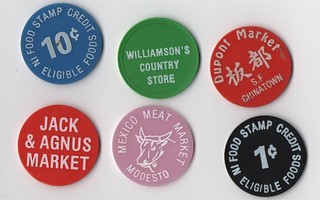
PREV ARTICLE
NEXT ARTICLE
FULL ISSUE
PREV FULL ISSUE
FOOD STAMP CHANGE TOKENS: A USER'S PERSPECTIVE
Web site visitor M Braun of New York City found our articles on food stamp change tokens and offers these thoughts from a user's
perspective. Thanks! -Editor
Many-perhaps most Americans know so little about this program that they are unaware that it was run by the USDA and that monthly, a purchase order was mailed to participants which had used a mathematical formula to decide both how many stamps a person could buy and how much they had to pay for them. Obviously, the system charged less than face value or no one would have bought them.-But not really much less-many stamp users had to pay 65C per dollar for stamps. Others only paid 30 cents on the dollar. It depended on the formula. In fact, so onerous and so expensive was the buying of the actual stamp booklets, that as many as half of most single persons (the highest payers in cash for stamps), often just sold their orders for extra "cash money" in actual dollars and cents. So miserly was the system, an order to purchase "$50" worth of USDA coupons which could be used ONLY to buy food items, not tobacco, not liquor, nor beer and often, many stores were so mean spirited that they tried refusing to sell items to stamp users on personal political grounds. What many of these middle level managers were not aware of was that each store owner who accepted USDA stamps was paid, in addition to their face value in real US money, another 10% . This means that buying anything with food stamps was paying 110 cents on the dollar for every purchase!!! This was a bonanza for any concern selling food stamps. They earned 1.10 cents for redeeming 1 dollar in stamps. The sellers of the stamps, if they bought the order for cash, received the difference between how much they paid and the full face value plus 10%, for the few dollars they paid for it. It was an all American hustle with druggists, bankers and all sorts of people getting into the business. THIS MEANT THAT HAVING TO GIVE USERS CRUMMY BUT EXPENSIVELY MADE PLASTIC, PAPER OR ALUMINUM TOKENS IN CHANGE COST ALMOST AS MUCH OR MORE THAN JUST GIVING OUT REAL CHANGE! Although, for any transaction, less than 99 cents in fake money change was given to anyone regardless if the purchase was 1 dollar or 100 dollars. The reasoning behind the use of tokens as change was that before the era of inflation of the 1980's, food stamp money could buy a lot of stuff most Americans were used to eating. The fear or excuse was that stamp users would take any and all cash change and buy tobacco, liquor or drugs. Ohhhh! For shame! In fact, every time some Senator voted to hang another sign on stamp users that read "I am a poor person who must be punished", the stamp users would often, to avoid losing purchasing power of REAL money, sell their stamps. Food stamps, being worth 10% more than dollars, sold for between 70 and 85% of face value. All of this was the fault of turning the recipients into poverty-stricken second class citizens who hated to use the funny money because of the stares and angry comments they often heard from other purchasers. This pretty much ended as, as many as a fifth or 20% of Americans had to use food stamps at one time or another. The issuance of cards has made the system almost invisible as now it is hard to tell a food stamp card (EB FT card). from a credit card. As a college student I qualified for stamps for a couple of years before Reagan. I always wanted to save a complete 10 dollar or 20 dollar "book". Stamps came in books, each one of which had a predetermined value, but I never had the ability to "waste" so much purchasing power. As a result, I have about 2 cents worth of Grand Union aluminum pennies. Unlike the change tokens, the actual food stamps were carefully and handsomely printed with a an easy to sense texture on one side. and their value and serial numbers clearly printed in black ink. The different stamp amounts were $1, $5, $10 and $20, as I recall. I am surprised to find anyone else who is interested in the era as it seemed non-existent on the internet before 2015. Go for it! I always wondered who made those colorful plastic "chips." Few people know that Food Stamps originated back in the FDR, depression era administrations. Stamps were not as common, once -the USDA gave out canned and prepared foods. One of which was the (I thought) quite tasty "Welfare Meat", a canned meat made of whatever meats were available to the USDA or canneries and meat processors working for the USDA and placed in cans without much information other than "Meat". Some people thought it had the consistency of a heavy dog food, but it tasted better. This was a delicacy I tried in 1967-it appears NYC ceased handling it as it was heavy and thus expensive to move. It stored for decades and much may have been from USDA war reserve stock (in event of a World War Three type event or floods and storms, the big US agencies kept such food stuff in huge refrigerated caves or other old aircraft hangers). To read the USDA's History of the program, see:
To read the earlier E-Sylum articles, see:
THE BOOK BAZARREWayne Homren, Editor The Numismatic Bibliomania Society is a non-profit organization promoting numismatic literature. See our web site at coinbooks.org. To submit items for publication in The E-Sylum, write to the Editor at this address: whomren@gmail.com To subscribe go to: https://my.binhost.com/lists/listinfo/esylum All Rights Reserved. NBS Home Page Contact the NBS webmaster 
|
